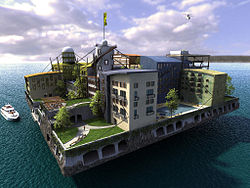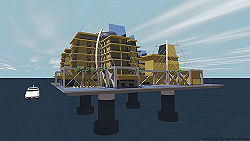- Seasteading
-
Seasteading is the concept of creating permanent dwellings at sea, called seasteads, outside the territories claimed by the governments of any standing nation. At least two people independently began using the term, a portmanteau of sea and homesteading: Ken Neumeyer in his book Sailing the Farm (1981) and Wayne Gramlich in his article "Seasteading – Homesteading on the High Seas" (1998).
Most proposed seasteads have been modified cruising vessels. Other proposed structures have included a refitted oil platform, a decommissioned anti-aircraft platform, and custom-built floating islands.[1] No one has created a state on the high seas that has been recognized as a sovereign nation, although the Principality of Sealand is a disputed micronation formed on a discarded sea fort near Suffolk, England.[2]
The closest things to a seastead that have been built so far are large ocean-going ships sometimes called "floating cities" and smaller floating islands.
Contents
Legal issues
Outside the Exclusive Economic Zone of 200 nautical miles (370 km), which countries can claim according to the United Nations Convention on the Law of the Sea, the high seas are not subject to the laws of any sovereign nation other than the flag under which a ship sails. Examples of organizations using this possibility are Women on Waves, enabling abortions for women in countries where abortions are subject to strict laws, and the pirate radio stations sailing the North Sea during the sixties. Like these organizations, a seastead might be able to take advantage of the looser laws and regulations that exist outside the sovereignty of nations, and be largely self-governing.
"When Seasteading becomes a viable alternative, switching from one government to another would be a matter of sailing to the other without even leaving your house," said Friedman at the first annual Seasteading conference.[3][4][5]
The Seasteading Institute
The Seasteading Institute, founded by Wayne Gramlich and Patri Friedman on April 15, 2008, is an organization formed to facilitate the establishment of autonomous, mobile communities on seaborne platforms operating in international waters.[3][6] Gramlich’s 1998 article "SeaSteading – Homesteading on the High Seas" outlined the notion of affordable steading, and attracted the attention of Friedman with his proposal for a small-scale project.[7] The two began working together and posted their first collaborative book online in 2001, which explored aspects of seasteading from waste disposal to flags of convenience.
The project picked up mainstream exposure in 2008 after having been brought to the attention of PayPal founder Peter Thiel, who invested $500,000 in the institute and has since spoken out on behalf of its viability, most recently in his essay "The Education of a Libertarian,"[8] published online by Cato Unbound. TSI has received widespread and diverse media attention, from sources such as CNN, Wired Magazine, and Prospect Magazine.[3][9] American journalist and commentator John Stossel wrote an article about seasteading and the Seasteading Institute in February of 2011 and invited Patri Friedman onto his show on the Fox Business Network.[10]
Designs
Retrofitted cruise ships
The first seasteads are projected to be cruise ships adapted for semi-permanent habitation. Cruise ships are a proven technology, and they address most of the challenges of living at sea for extended periods of time. The cost of the first shipstead was estimated at $10M.[11]
Spar Platform
The Seasteading Institute has been working on communities floating above the sea in spar buoys, similar to oil platforms.[12] The project would start small, using proven technology as much as possible, and try to find viable, sustainable ways of running a seastead.[13] Innovations that enable full-time living at sea will have to be developed. The cruise ship industry's development suggests this may be possible.
A proposed design for a custom-built seastead is a floating dumbbell in which the living area is high above sea level, which minimizes the influence of waves. During the last couple of years, research has been documented in an online book that covers living on the oceans.[14]
The Seasteading Institute focuses on three areas: building a community, doing research and building the first seastead in the San Francisco Bay. In January 2009, The Seasteading Institute patented a design for a 200-person resort seastead, ClubStead, about a city block in size, produced by consultancy firm Marine Innovation & Technology. ClubStead marks the first major development in hard engineering, from extensive analysis to simulations, of the seasteading movement.[14][15]
Modular Island
At the Seasteading Institute Forum, an idea arose to create an island from modules.[16] There are several different designs for the modules, with a general consensus that Reinforced concrete is the most proven, sustainable and cost-effective material for seastead structures,[17] as indicated by use in oil platforms and concrete submarines.
Other
Many architects and firms have created designs for floating cities, including Vincent Callebaut[18][19], Paolo Soleri[20] and companies as Shimizu and Tangram 3DS[21]. Marshall Savage also discussed building tethered artificial islands in his book The Millennial Project: Colonizing the Galaxy in Eight Easy Steps, with several color plates illustrating his ideas.
Progress
Friedman and Gramlich had hoped to float the first prototype seastead in the San Francisco Bay by 2010[22][23] but current plans are to launch a seastead by 2014.[24]. The Seasteading Institute projects that in 2014, the seasteading population will exceed 150 individuals.[25]
In July 2011, two employees of The Seasteading Institute left The Institute to start a for-profit seasteading venture, Blueseed.[26]
Conferences
The Seasteading Institute held its first annual conference in Burlingame, California, October 10, 2008. 45 people from 9 countries attended.[27] The second annual Seasteading conference was significantly larger, and held in San Francisco, California, September 28–30, 2009.[28][29]
The first "Ephemerisle" event was held October 2–4, 2009, on the Sacramento River delta in California.[30] A second Ephemerisle event scheduled for July 22–25, 2010, was canceled by organizers.[31] TSI cited "unexpectedly high insurance costs" as the reason and stated that it would indefinitely postpone plans for a future Ephemerisle to concentrate on its research initiatives.[32] However, many attendees still gathered in the same location for a grassroots community weekend consisting of informal presentations, talks and socializing.[33]
See also
- Arcology
- Artificial island
- Biorock
- Deep sea mining
- Floating airport
- Jacque Fresco
- HavenCo
- Mariculture
- Marine energy
- Mobile offshore base
- Ocean thermal energy conversion
- Pneumatic stabilized platform
- Republic of Minerva
- Russian floating nuclear power station
- Seawater Greenhouse
- Telepossession
- Underwater habitat
- Very large floating structure
- Wolf Hilbertz
References
- ^ Mangu-Ward, Katherine (April 28, 2008). "Homesteading on the High Seas: Floating Burning Man, "jurisdictional arbitrage," and other adventures in anarchism". Reason Magazine. http://reason.com/news/show/126198.html. Retrieved 2009-02-28.
- ^ Danny O'Brien, "Explorers in the Valley still charting new territory", Irish Times, Sep. 19, 2008.
- ^ a b c Baker, Chris (January 19, 2009). "Live Free or Drown: Floating Utopias on the Cheap". Wired Magazine. http://www.wired.com/techbiz/startups/magazine/17-02/mf_seasteading. Retrieved 2009-01-19.
- ^ Alexis Madrigal, "Peter Thiel Makes Down Payment on Libertarian Ocean Colonies", Wired Science, May. 19, 2009.
- ^ "City floating on the sea could be just 3 years away". CNN. March 3, 2009. http://www.cnn.com/2009/TECH/03/09/floating.cities.seasteading/index.html. Retrieved 2009-03-10.
- ^ "History". http://seasteading.org/about-tsi/history.
- ^ http://gramlich.net/projects/oceania/seastead1.html
- ^ Peter Thiel (April 13, 2009). "The Education of a Libertarian". http://www.cato-unbound.org/2009/04/13/peter-thiel/the-education-of-a-libertarian/.
- ^ Seasteading: the great escape, Prospect Magazine, April 2010
- ^ http://reason.com/archives/2011/02/17/is-seasteading-the-future
- ^ "About Seasteading - Frequently Asked Questions". The Seasteading Institute. http://seasteading.org/about-seasteading/frequently-asked-questions. Retrieved 2011-06-03.
- ^ McCullagh, Declan (February 2, 2009). "Next Frontier: "Seasteading" The Oceans". CBS News. http://www.cbsnews.com/stories/2009/02/02/tech/cnettechnews/main4769336.shtml. Retrieved 2009-02-28.
- ^ May Young, Niki (May 22, 2008). "The Seasteading Institute established to develop permanent ocean communities.". World Architecture News. http://www.worldarchitecturenews.com/index.php?fuseaction=wanappln.projectview&upload_id=2345. Retrieved 2009-02-28.
- ^ a b Gramlich, Wayne; Friedman, Patri; Houser, Andrew (2002-2004). "Seasteading". seasteading.org. http://seasteading.org/seastead.org/commented/paper/index.html. Retrieved 2009-02-28.
- ^ "ClubStead". seasteading.org. 2009. http://seasteading.org/strategic-areas/engineering/clubstead. Retrieved 2009-06-02.
- ^ http://seasteading.org/interact/forums/engineering/structure-designs/modular-island-design
- ^ http://seasteading.org/interact/forums/engineering/structure-designs/apply-seasteading-concrete-shell-structures
- ^ Vincent Callebaut Lilypad
- ^ "LILYPAD, A Floating Ecopolis for Ecological Refugees"
- ^ Rose, Steve (August 25, 2008). "The man who saw the future". The Guardian (London). http://www.guardian.co.uk/artanddesign/2008/aug/25/architecture.ethicalliving. Retrieved May 23, 2010.
- ^ Floating city designs
- ^ Frucci, Adam. "Silicon Valley Nerds Plan Sea-Based Utopian Country to Call Their Own", Gizmodo, 5-20-08
- ^ Park, Bryant. "Libertarian Island: No Rules, Just Rich Dudes", National Public Radio, 5-21-08
- ^ "Meetup.com - October 2010 Seasteading Social at the Hyatt Regency SF". http://www.meetup.com/sfbay-seasteading/calendar/14479560/. Retrieved 20 October 2010.
- ^ "Seasteading: A Possible Timeline". http://seasteading.org/mission/additionalreading/timeline. Retrieved 20 October 2010.
- ^ Friedman, Patri. "The Seasteading Institute July 2011 Newsletter". http://seasteading.org/blogs/main/2011/07/31/the-seasteading-institute-july-2011-newsletter. Retrieved 2011-Sep-06.
- ^ "Seasteading Institute 2008 Annual Report". TSI. April 15, 2009. http://seasteading.org/files/annualreportfinal.pdf. Retrieved 2009-08-12.
- ^ "Seasteading 2009 Annual Conference". TSI. August 10, 2009. http://seasteading.org/stay-in-touch/press-releases/the-seasteading-institute-announces-its-second-annual-conference. Retrieved 2009-08-12.
- ^ McCullagh, Declan (2009-10-11). "Seasteaders Take First Step Toward Colonizing The Oceans". CBSNews. http://www.cbsnews.com/blogs/2009/10/11/taking_liberties/entry5377477.shtml. Retrieved 2009-10-12.
- ^ "2009 Gallery". Ephemerisle.org. 2009. http://ephemerisle.org/art-projects/2009-gallery/. Retrieved 2010-06-29.
- ^ "Ephemerisle 2010 Cancellation". Ephemerisle.org. 2010-06-18. http://ephemerisle.org/2010/06/ephemerisle-2010-cancellation/. Retrieved 2010-06-29.
- ^ "Ephemerisle Program Update". Seasteading.org/. 2010-11-04. http://seasteading.org/blogs/main/2010/11/04/ephemerisle-program-update. Retrieved 2010-11-20.
- ^ "UnEphemerisle 2010 Report". http://wiki.seasteading.org/index.php/UnEphemerisle2010. Retrieved 20 October 2010.
External links
- The Seasteading Institute
- Seasteading - Frequently Asked Questions
- Blueseed - for-profit seasteading venture
- Las Portadas (underwriting, arbitration, and government interface)
- The Seasteader's Institute, Oceania: The Atlantis Project (precursor projects, now abandoned)
Categories:
Wikimedia Foundation. 2010.


